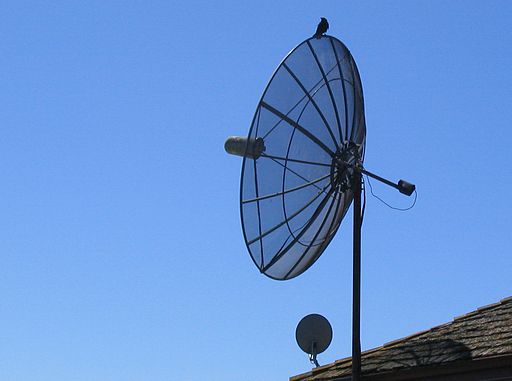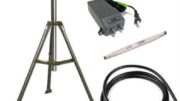The first satellite transmissions were 100% free.
When Telstar, the first communications satellite to carry television signals, went live in 1962, there was nothing else like it. All it took was a very large antenna and anyone could get TV signals from space. Of course, it was a little harder than that at first — you would have to build your own dish, your own receiver, wire your own house… but who couldn’t do that?
In fact, the cost and complexity of satellite reception equipment meant that there was no need to put any sort of copy protection or encryption on satellite services. For over a decade, satellite delivery was left to television networks and cable companies who could afford the high price of the equipment and maintenance.
By the 1980s, there were several companies selling satellite dishes like the one pictured above. Kits were available from Radio Shack and had everything you would need to get free HBO, ESPN, or any other channel that distributed over satellite. Needless to say the idea of giving away their programming didn’t sit well with the large companies that owned these channels, and they began to encrypt their signals. Any unencrypted signals that were left were referred to as “Free to Air,” or FTA.
Around the same time, the US government began to set standards for completely encrypted satellite transmissions that were intended for consumer use. The technology became known as Direct Broadcast Satellite, or DBS, and the goal was to create a satellite dish small enough to be easily mounted on the roof and a receiver that was as easy to use as a cable box. Oh, and of course being able to charge for the service was a nice touch.
FTA hobbyists thumbed their noses at DBS, preferring to take their chances with their large, expensive dishes and criticizing anyone who chose to pay for satellite services. By 2000, two groups of FTA hobbyists had formed: those who simply used their dishes to legitimately get free signals, and an underground group dedicated to hacking encrypted signals.
Throughout the 2000s, however, the C-Band FTA dish became less common, and it became known as a “BUD” or “big ugly dish” to those who chose to use the smaller DBS dishes that became much more popular. FTA satellite reached a low point, as better encryption systems combined with the rise of internet video made FTA less appealing.
Enter IKS… the mix of internet and satellite.
IKS stands for Internet Key Sharing and is a technology that uses the internet and a legitimate decryption system to provide satellite service for more than one receiver. It is not illegal by its nature but it can be used to circumvent the copy protection policies established by satellite providers. In an IKS system, a smart card reader reads the decryption key that would normally be used for a single satellite receiver. This reader feeds its information to a server, which sends the smart card information throughout the internet. The smart card information can then be used by multiple receivers to get access to encrypted satellite.
That sounds like a complex system but the internet makes it simple if you have the right hardware. While IKS can be used to provide backup services for commercial TV accounts like bars and restaurants, it can also be used by people who want to get satellite programming without paying for it.
It’s important to know that most of the equipment needed for FTA reception, with or without IKS, is not illegal to buy and not illegal to operate. However like any other technology it can be used for good or evil. Using an FTA receiver is a fun way to get extra HD channels or get television service where it’s otherwise impossible to do. There are also very legitimate uses for IKS systems. Those who choose to use these systems to break the law or steal service do so at their own risk, of course.
Hobbyists continue to use FTA to find new sources of entertainment and there’s absolutely nothing wrong with that.





